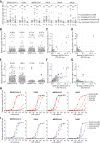Broad betacoronavirus neutralization by a stem helix-specific human antibody
- PMID: 34344823
- PMCID: PMC9268357
- DOI: 10.1126/science.abj3321
Broad betacoronavirus neutralization by a stem helix-specific human antibody
Abstract
The spillovers of betacoronaviruses in humans and the emergence of severe acute respiratory syndrome coronavirus 2 (SARS-CoV-2) variants highlight the need for broad coronavirus countermeasures. We describe five monoclonal antibodies (mAbs) cross-reacting with the stem helix of multiple betacoronavirus spike glycoproteins isolated from COVID-19 convalescent individuals. Using structural and functional studies, we show that the mAb with the greatest breadth (S2P6) neutralizes pseudotyped viruses from three different subgenera through the inhibition of membrane fusion, and we delineate the molecular basis for its cross-reactivity. S2P6 reduces viral burden in hamsters challenged with SARS-CoV-2 through viral neutralization and Fc-mediated effector functions. Stem helix antibodies are rare, oftentimes of narrow specificity, and can acquire neutralization breadth through somatic mutations. These data provide a framework for structure-guided design of pan-betacoronavirus vaccines eliciting broad protection.
Figures





References
-
- Thomson E. C., Rosen L. E., Shepherd J. G., Spreafico R., da Silva Filipe A., Wojcechowskyj J. A., Davis C., Piccoli L., Pascall D. J., Dillen J., Lytras S., Czudnochowski N., Shah R., Meury M., Jesudason N., De Marco A., Li K., Bassi J., O’Toole A., Pinto D., Colquhoun R. M., Culap K., Jackson B., Zatta F., Rambaut A., Jaconi S., Sreenu V. B., Nix J., Zhang I., Jarrett R. F., Glass W. G., Beltramello M., Nomikou K., Pizzuto M., Tong L., Cameroni E., Croll T. I., Johnson N., Di Iulio J., Wickenhagen A., Ceschi A., Harbison A. M., Mair D., Ferrari P., Smollett K., Sallusto F., Carmichael S., Garzoni C., Nichols J., Galli M., Hughes J., Riva A., Ho A., Schiuma M., Semple M. G., Openshaw P. J. M., Fadda E., Baillie J. K., Chodera J. D., ISARIC4C Investigators, COVID-19 Genomics UK (COG-UK) Consortium, Rihn S. J., Lycett S. J., Virgin H. W., Telenti A., Corti D., Robertson D. L., Snell G., Circulating SARS-CoV-2 spike N439K variants maintain fitness while evading antibody-mediated immunity. Cell 184, 1171–1187.e20 (2021). 10.1016/j.cell.2021.01.037 - DOI - PMC - PubMed
-
- McCallum M., De Marco A., Lempp F. A., Tortorici M. A., Pinto D., Walls A. C., Beltramello M., Chen A., Liu Z., Zatta F., Zepeda S., di Iulio J., Bowen J. E., Montiel-Ruiz M., Zhou J., Rosen L. E., Bianchi S., Guarino B., Fregni C. S., Abdelnabi R., Foo S.-Y. C., Rothlauf P. W., Bloyet L.-M., Benigni F., Cameroni E., Neyts J., Riva A., Snell G., Telenti A., Whelan S. P. J., Virgin H. W., Corti D., Pizzuto M. S., Veesler D., N-terminal domain antigenic mapping reveals a site of vulnerability for SARS-CoV-2. Cell 184, 2332–2347.e16 (2021). 10.1016/j.cell.2021.03.028 - DOI - PMC - PubMed
Publication types
MeSH terms
Substances
Grants and funding
LinkOut - more resources
Full Text Sources
Other Literature Sources
Miscellaneous

